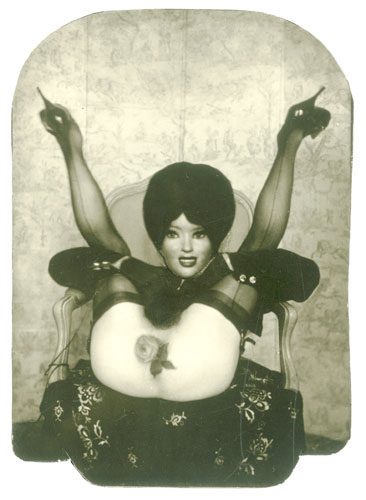Pierre Molinier: The White Rose, c. 1967 Unique photographic collage, 5 1/4 x 3 3/4 inches The White Rose Hans Bellmer, Pierre Molinier, Wangechi Mutu, Janaina Tschäpe Brent Sikkema is pleased to present "The White Rose", an exhibition featuring the work of Hans Bellmer, Pierre Molinier, Wangechi Mutu and Janaina Tschäpe. The exhibition takes its title from a well-known Pierre Molinier photograph in which the artist, dressed as a woman and wearing a mask, is suggestively photographed with a rose. Like Molinier, the artists in "The White Rose" share an interest in the various manifestations of the female body. By playfully yet purposefully manipulating its appearance, each seeks to open a dialogue on cultural representations of the human form, exploring such issues as gender, race, identity and sexuality. Hans Bellmer (1902-1975) is best known for the life-like mannequins he created and photographed in the 1930s. These assemblages were sculptural approximations of the female form explicit in their sexual implications and subversive in their psychological insinuations. Through the doll - or "La Poupée" - the artist comments not only on repressed sexual desire, but also on the dominant representations of gender that circulated at the time (particularly in the Fascist ideology of the Nazi party in Bellmer's native Germany). The exhibition will include both photographs and the artist's drawings. At the age of 60, Pierre Molinier (1900-1976) began a series of extremely stylized photographs that placed him in the center of his own work as a subject, consumer, and object of desire. Employing a range of masks and props, Molinier posed as a transvestite clad in fishnet stockings, corsets and stiletto heels. In Surrealist fashion, the artist employed photomontage and retouching as a means to manipulate and exaggerate feminine features, or to add multiple bodies and body parts. Through Molinier's work we are party to the artist's unapologetic exploration of the body's role in the creation of personal fantasy. In this work, the body is open to interpretation, to be molded and shaped in any image. Working in a range of media - including drawing, photo-collage, installation and film - Wangechi Mutu positions the female body as a site for investigating history and culture. Mutu's bodies are hybrids - a mixture of animal, vegetal, and machine - that escape classification. In this exhibition, Mutu will present a new series of works on Mylar, titled "Forensic Forms". For the artist, these works represent a search for a primal form or a "first face" - that which signifies humanity before we begin to understand how we are distinct from one another. Drawing on anthropology, ethnology, ethnography and phrenology, these works unveil the naïve and sinister arbitrariness that has historically characterized these fields. Janaina Tschäpe's drawings, films, and photographs take an interest in the human body as a sculptural entity. Tschäpe often collaborates with a group of female friends who pose as models, wearing costumes the artist has made from latex, cloth, condoms and balloons. In these works, Tschäpe's characters wear the lumpy malleable insides of their flesh like clothing. Water seems to be omnipresent, whether in the landscape or in the amoeba-like forms of anthropomorphic figures. In "The White Rose", Tschape will present work from her recent series, "Blood, Sea," which explores the watery origins of humanity. Through its manipulated and metaphorical form, the body becomes a blank canvas on which the viewer can paint their imagination, free from the mundane restrictions of reality. Exhibition: April 22 . May 21, 2005 Gallery hours: Tues-Sat 10 am - 6 pm Brent Sikkema 530 W 22nd St USA-New York, NY 10011 Telephone + 1 212 929 2262 Fax + 1 212 929 2340 Email gallery@brentsikkema.com www.brentsikkema.com |
|
